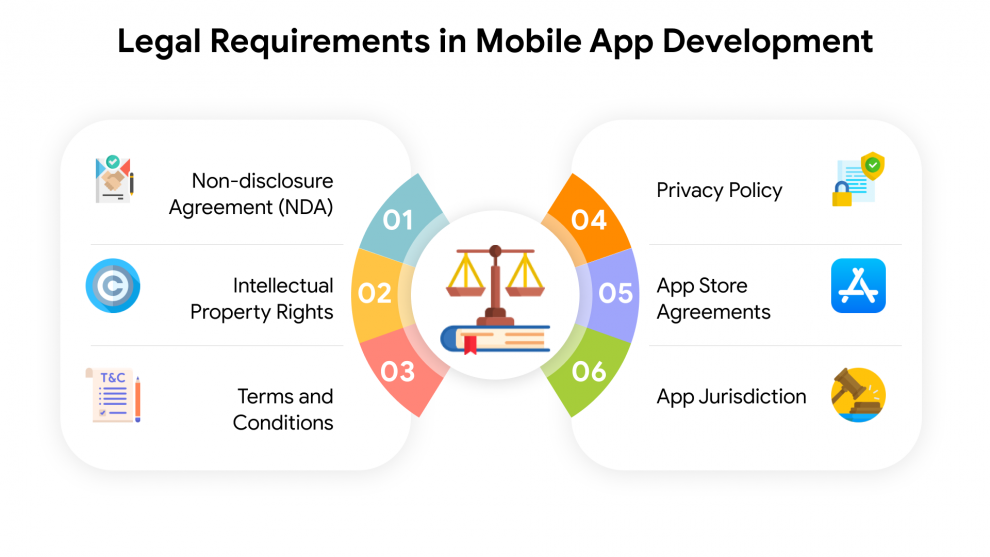Navigating the legal aspects for app development in the United States is a critical aspect that developers and businesses must address comprehensively. It involves a multifaceted approach to ensure legal compliance, protect intellectual property, and maintain trust with users. One primary consideration is safeguarding intellectual property rights. Developers should ascertain ownership or proper usage rights for all app components, from code to visual assets. Registering trademarks for the app’s name and logo can also establish brand protection.
Data privacy and security are paramount. App developers must adhere to data protection laws like the California Consumer Privacy Act (CCPA) and the Children’s Online Privacy Protection Act (COPPA). This entails transparent data collection practices, user consent, and robust data security measures. Clear and comprehensive terms of service and privacy policies are essential documents that outline user rights, responsibilities, and data handling practices. Regular updates to these documents ensure alignment with evolving legal standards. Ensuring accessibility for users with disabilities, in compliance with the Americans with Disabilities Act (ADA), is essential. This involves implementing features such as screen readers and voice commands.
App developers must also adhere to app store guidelines, as violations can result in app removal. Contracts with contractors, developers, and third-party services should be meticulously defined to protect interests and outline dispute-resolution processes. Understanding and compliance with consumer protection laws, copyright infringement rules, patents, and industry-specific regulations are integral components of the legal framework. Additionally, robust security measures and measures to address data breaches are crucial to mitigate legal liabilities.
Legal Requirements for Apps and Tips to Meet Them

Creating a successful and legally compliant mobile app requires adherence to specific legal requirements. Here are five essential legal considerations for app developers and some tips on how to meet them:
Privacy and Data Protection :
Protecting user data is paramount. Your app should strictly adhere to data protection laws, such as GDPR or CCPA, by clearly explaining data collection practices in your privacy policy. Obtain informed user consent for data collection, and ensure secure storage and transmission of user information to safeguard privacy. Your app must comply with data protection regulations, such as the General Data Protection Regulation (GDPR) in Europe or the California Consumer Privacy Act (CCPA) in the United States. This involves several key aspects:
- Transparent Data Practices: Clearly explain in your privacy policy how user data is collected, processed, and used within your app. Users should have a complete understanding of what data you collect and why.
- User Consent: Obtain informed and explicit consent from users before collecting any personal information. Implement mechanisms within your app to request and record user consent.
- Secure Data Handling: Ensure that user data is securely stored and transmitted. Implement encryption and other security measures to protect data from unauthorized access or breaches.
- Data Retention Policies: Define and adhere to data retention policies, specifying how long user data will be retained and for what purposes. Data should not be kept longer than necessary.
Terms of Service and Privacy Policy :
Comprehensive terms of service and privacy policy documents are essential. They serve as the legal contract between your app and users, outlining user rights, responsibilities, and data usage practices. Regularly update these documents to reflect any changes in your app’s functionality or data handling procedures.
Terms of Service (ToS): Your app’s ToS document should include:
- User Rights and Responsibilities: Clearly state what users can and cannot do while using your app. This might include guidelines for acceptable behaviour, prohibited actions, and intellectual property rights.
- Termination Clause: Specify conditions under which you can terminate a user’s access to your app, such as violation of the ToS or misuse of the app.
Privacy Policy: Your app’s Privacy Policy document should cover:
- Data Collection: Clearly describe what data your app collects from users, including personal and non-personal information. Be specific about the types of data collected and the methods used.
- Data Usage: Explain how you use the collected data. This includes purposes such as app functionality, analytics, advertising, and third-party services.
Intellectual Property Rights :
Avoid copyright and trademark infringements by verifying ownership or licensing rights for all app components, including code, images, and content. Legal diligence here is crucial to protect your app from potential legal disputes and intellectual property claims.
- Ownership Verification: Ensure that you either own the rights to all elements used in your app or have obtained the necessary licenses or permissions. Verify the origin and legality of all intellectual property assets.
- Code Ownership: If your app includes custom code or software libraries, clarify ownership and licensing terms. Be aware of open-source licenses, which may have specific usage requirements.
- Image and Graphics Usage: If you use images, graphics, or icons in your app, verify that you have the rights to use them. Purchase stock images or hire a designer to create custom graphics when necessary.
Accessibility Standards :
Make your app inclusive by adhering to accessibility standards like the ADA. Implement features such as screen readers and provide alt text for images to ensure that users with disabilities can fully engage with your app.
Here’s how to address accessibility standards:
- Screen Readers: Implement support for screen readers, which are assistive technologies that read aloud on-screen content. Ensure that all app elements, including buttons, labels, and text, are properly labelled for screen reader users.
- Keyboard Navigation: Make sure your app can be fully operated using only a keyboard. This includes keyboard shortcuts, focus indicators, and logical navigation order.
- Alt Text for Images: Provide descriptive alt text for all images in your app. Alt text should convey the content and purpose of the image to users who cannot see it.
App Store Guidelines Compliance:
To prevent app removal, follow the guidelines and policies of app stores like Apple’s App Store and Google Play Store. Understanding and complying with these store-specific requirements is essential for maintaining a presence on these platforms. Here’s how to address App Store guidelines compliance:
- Familiarize Yourself with Guidelines: Thoroughly review the guidelines provided by the specific app store where you plan to distribute your app. Both Apple and Google have their own sets of guidelines, which can change over time.
- Design and Content: Ensure that your app’s design, content, and functionality align with the guidelines. This includes adhering to design principles, avoiding offensive or objectionable content, and providing a consistent user experience.
- App Store Review Process: Understand the app review process, including the criteria for approval or rejection. Be prepared for possible rejections and have a plan for addressing feedback and resubmitting your app.
Consumer Protection Laws :
To maintain transparency and trust, your app must comply with federal and state consumer protection laws. This ensures that your app avoids deceptive advertising, fraudulent practices, and false claims. Here’s how to address consumer protection laws:
- Transparency and Accuracy: Provide clear, accurate, and complete information about your app’s features, pricing, and functionality. Avoid deceptive advertising or misrepresentation of your app’s capabilities.
- Truthful Advertising: Ensure that all promotional materials, including app descriptions, advertisements, and marketing campaigns, are truthful and do not make false claims about your app.
- In-app purchases: If your app offers in-app purchases, clearly communicate pricing, terms, and conditions to users. Avoid tactics that may pressure or manipulate users into making unintended purchases.
Copyright Infringement :
Prevent copyright violations by respecting the rights of others. Ensure that your app does not infringe on the copyrights of third-party content. Obtain licenses or permissions when necessary and adhere to fair use principles.
Here’s how to address and avoid copyright infringement:
- Ownership Verification: Ensure that you either own the rights to all app content or have obtained the necessary licenses, permissions, or agreements from the rightful owners. This includes images, text, music, videos, and software components.
- Public Domain and Free Resources: Use content that is in the public domain or licensed under terms that permit reuse and modification. Be cautious when using “free” resources, as some may have usage restrictions.
- Fair Use Doctrine: Familiarize yourself with the fair use doctrine, which allows limited use of copyrighted material without permission for purposes such as criticism, commentary, news reporting, education, and parody. Ensure that your app’s use of copyrighted material falls within fair use guidelines.
User Agreements :
Implement user-friendly mechanisms, such as checkboxes and notifications, to obtain user consent for terms of service and privacy policies. This enhances transparency and ensures that users are aware of and agree to your app’s legal terms.
Here’s how to address user agreements effectively:
- Clear and Accessible Language: Draft user agreements in clear and understandable language. Avoid complex legal jargon that may confuse users. The goal is to ensure that users can easily comprehend their rights and responsibilities.
- Scope of Agreement: Clearly define the scope of the agreement, specifying which aspects of the app and its usage it covers. Explain what constitutes acceptance of the agreement, such as downloading or using the app.
- User Consent: Implement mechanisms within the app, such as checkboxes or pop-up notifications, to obtain user consent for the terms of service and privacy policy. Users should actively agree to the terms.
COPPA Compliance :
If your app targets children under 13, strict compliance with COPPA regulations is necessary. This includes obtaining parental consent for data collection and adhering to stringent child privacy protection requirements.
Here’s how to address user agreements effectively:
- Clear and Accessible Language: Draft user agreements in clear and understandable language. Avoid complex legal jargon that may confuse users. The goal is to ensure that users can easily comprehend their rights and responsibilities.
- Scope of Agreement: Clearly define the scope of the agreement, specifying which aspects of the app and its usage it covers. Explain what constitutes acceptance of the agreement, such as downloading or using the app.
- User Consent: Implement mechanisms within the app, such as checkboxes or pop-up notifications, to obtain user consent for the terms of service and privacy policy. Users should actively agree to the terms.
Security Measures :
Protect user data and sensitive information by implementing robust security measures. Regularly audit your app for potential vulnerabilities and have a security breach response plan in place.
Here are key security measures to consider:
- Data Encryption: Implement strong encryption algorithms to protect data both in transit and at rest. Use technologies like TLS/SSL for data transmission and encryption libraries for storing sensitive data securely.
- Secure Authentication: Use secure authentication methods, such as multi-factor authentication (MFA) or biometric authentication (e.g., fingerprint or facial recognition), to verify user identities.
- Password Policies: Enforce strong password policies, including complexity requirements and regular password changes. Store passwords securely using hashing and salting techniques.
Regulatory Compliance :
Some industries, like healthcare or finance, have specific regulatory requirements. Seek legal counsel to navigate these complex areas, ensuring your app complies with all applicable industry-specific regulations.
Here’s how to address regulatory compliance:
- Identify App Categories: Determine which regulatory categories apply to your app. Common categories include data privacy, medical devices, finance, children’s apps, and gambling.
- Data Privacy Laws: Comply with data privacy laws applicable to your app’s users. This may include GDPR (European Union), CCPA (California), HIPAA (healthcare), or other regional laws. Obtain user consent for data collection, storage, and processing.
- Medical Device Regulations: If your app is a medical device or intended for medical use, adhere to regulatory requirements, such as FDA (U.S.) or CE marking (EU). Comply with safety, performance, and data security standards.
Compliance with these legal requirements is essential to ensure your app’s legality, protect user interests, and minimize the risk of legal issues. Consulting with legal experts who specialize in technology and app development can provide invaluable guidance in navigating these legal complexities.

















